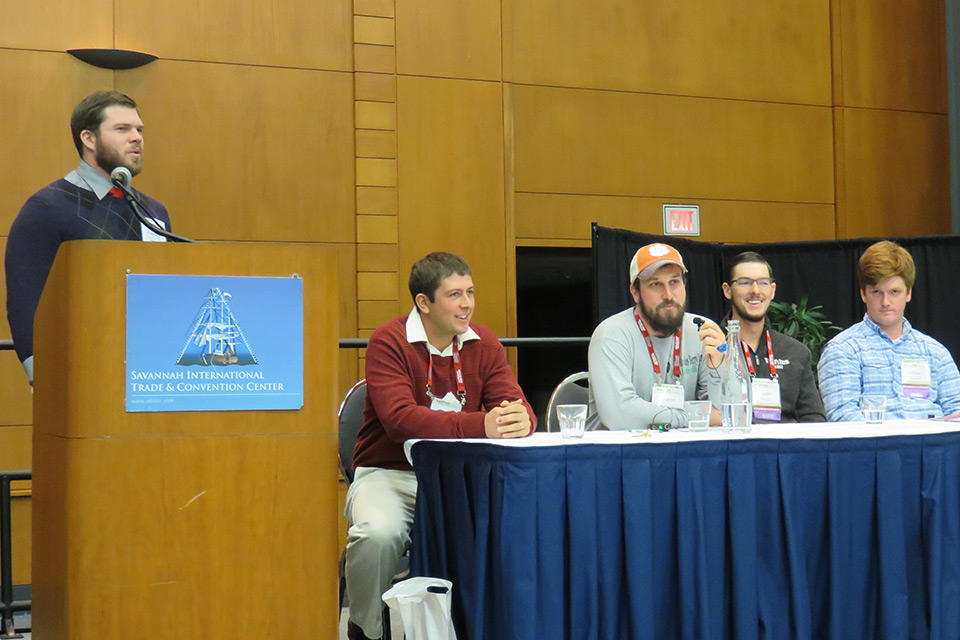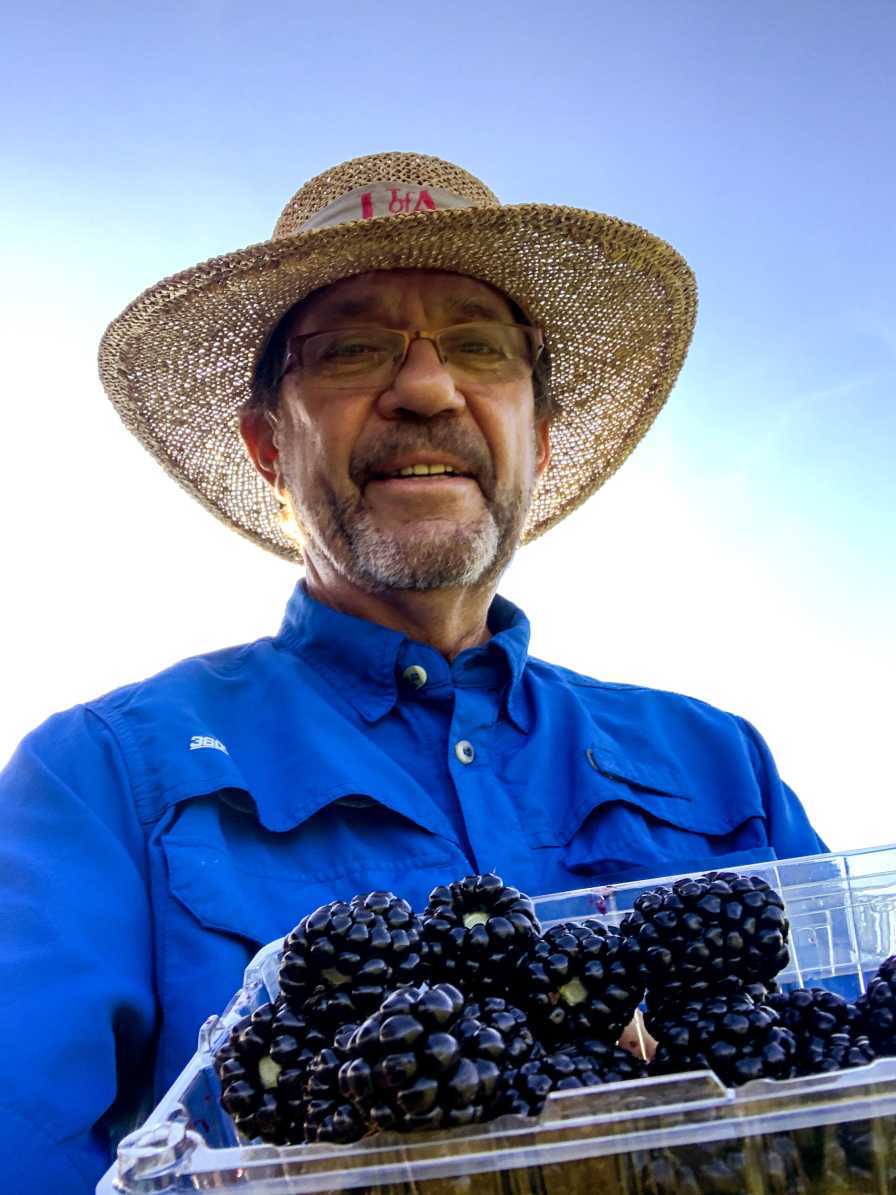NARBA Conference Highlights Strong Market for Berries

The future of the berry industry looks bright as young growers (from left) Pierson Geyer, Ethan Lineberger, Dalton Rhodes, Austin Wrenn, and William Moses discuss what it’s like to join the industry and how the transition in operation can occur.(Photo: Dorothy Hammett, NARBA)
I am a big fan of grower meetings, even with the advent of the internet-based information we have at hand these days. One area of my job that I truly enjoy is speaking at grower meetings; I have been fortunate to see changes resulting from these presentations, plus I simply appreciate the opportunity to share some of my life’s work as a berry breeder.
The North American Raspberry and Blackberry Growers Association (NARBA) meets early each year and is one of the best opportunities to take part in if one is interested in caneberries, particularly fresh-market raspberry and blackberry production. The meeting moves around the country, this year in Savannah, GA, in conjunction with the Southeast Regional Fruit & Vegetable Conference.
I was honored to speak at the 2019 NARBA meeting. This also gave me an opportunity to hear first-hand about some important topics for growers. I highlight a few of these as follows.
Markets
Presentations and speaker comments had a strong focus on markets. The commercial shipping market continues to be very positive for caneberries, according to Roland Fumasi, Vice President, Senior Analyst and Manager for Rabobank’s RaboResearch Food & Agribusiness division. Roland’s primary message was that caneberries have gained market share in recent years, with per capita consumption growing 17% annually over the past decade; the highest growth rate among all fruits and nuts.
For blackberries, Fumasi pointed out the multi-year average price for blackberries tends to be highest in the domestic U.S. season of weeks 24 to 41. He also said though red raspberries had experienced a steep price decline in 2014-15, production has adjusted since then and has provided for increased grower prices. Overall, the caneberry market is positive for U.S. fresh-market producers.
Local market production continues to be a focus of many caneberry growers, with pick-your-own (PYO), on-farm sales, and other direct-market options providing good pricing and grower profits. Chris Eckert of Eckerts Inc., Belleville, IL, shared that blackberries continue to be a hot item in his operation, with PYO being most important. His experiences using the rotatable crossarm trellis (RCA) have been very positive, and customers love the picking; harvesting as much as 5 pounds of fruit in 5 minutes.
Pierson Geyer at Agriberry Farm in Hanover, VA, said diversifying their market through community-supported agriculture (CSA), a dozen farmers’ markets, and a few wholesale outlets allow their farm to handle production peaks and valleys and grow berry sales. He has been particularly pleased with their CSA, where more than 600 members receive berries over a 20-week season.
Grower Insights
This Southeastern NARBA conference turned its “Grower Spotlight” on one of its own, Steve McMillan of Enigma, GA. Steve told the story of how in the late 1990s to early 2000s his family needed to examine alternative crops to tobacco. His family established a small planting of strawberries and then added a few blackberries, for PYO, and sales at a roadside stand. He found he could produce more blackberries than he could market locally, and he began taking blackberries to farmers markets, including in Atlanta. As interest grew in commercial blackberries for shipping, he expanded to 25 acres. His operation now includes 75 acres of blackberries for shipping.
A panel of young growers — Pierson Geyer of Virginia, William Moses of Georgia, and Ethan Lineberger, Dalton Rhodes, and Austin Wrenn, all of North Carolina — provided inspiration as they shared their reasons to enter into professional berry farming. A common theme was their interest in being able to work outdoors and working with family members, particularly for the succession of their farms. It was encouraging to experience their enthusiasm and excitement for berry production and made me feel very encouraged that the next generation can do an even better job than previous generations!
Production and Cultural Management
One afternoon track of sessions focused entirely on high tunnel and substrate production. Eric Hanson from Michigan State University shared findings from research he has been involved with showing positive production impacts for red raspberries in high tunnels grown in soil. Benefits included increased yields and fruiting season extension, both earlier and later ripening. Double cropping (floricane and primocane crop) resulted in the highest yields in tunnels for red raspberries. High tunnels also contributed to reduced botrytis fruit rot and Japanese beetle damage but lead to more powdery mildew and spider mites.
Jimmy Hewitt with Lewis Nursery and Farms, Rocky Point, NC, emphasized the value of high tunnels in blackberry production for protection from rains as well as the diffusion of light with appropriate plastic selection. Threats included potential storm damage and heat damage to berries if tunnels are improperly vented. Costs for tunnel construction and maintenance are substantial and have to be considered before undertaking this major investment. Although high tunnels for blackberry production are rarely used in the Southeast, their use is increasing.
Breeding and New Varieties
Several breeding programs were represented here. Felicidad Fernandez of the NIAB EMR (National Institute of Agricultural Botany, East Malling Research) program in the U.K. updated attendees on their long-standing red raspberry breeding program and their new releases ‘Malling Charm’ and ‘Malling Bella.’ Chad Finn with USDA-ARS in Oregon, though unable to present, provided information on three new varieties, ‘Eclipse,’ ‘Galaxy,’ and ‘Twilight,’ the first from his program that blends Eastern and Western blackberry genetics. I shared about the new University of Arkansas blackberry named ‘Caddo,’ a good flavored, floricane-fruiting option newly available.
Looking Ahead and Membership
Next year’s NARBA meeting will be held in St Louis, MO, March 3-6, 2020. I encourage anyone either in the raspberry- or blackberry-growing business, or those considering planting these crops, to plan to attend. As I often say, one can never know too much! For those interested in NARBA membership or learning more about NARBA and its conference, contact Debby Wechsler at [email protected]. I hope to see you at NARBA next year. And let the Berry Good Times Roll!










